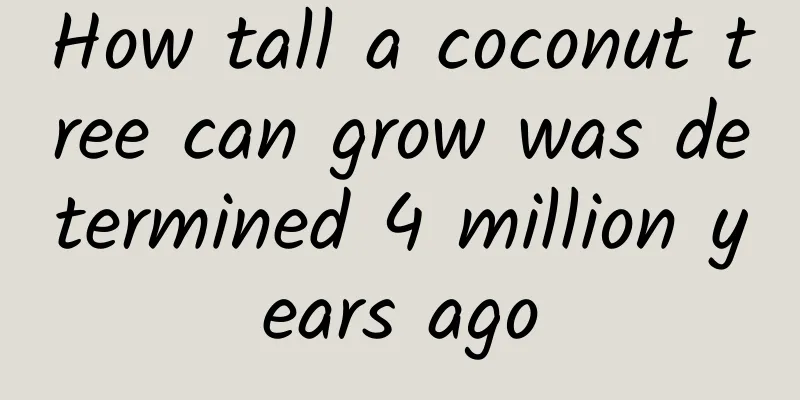How tall a coconut tree can grow was determined 4 million years ago

|
Coconut is an important tropical oil and fruit crop with a variety of characteristics. For example, some plants are taller than others, some have more or less coconut meat, and some have larger or smaller shells. What causes these differences? There are many mysteries to be solved about coconut. Recently, in a paper published in Genome Biology, a research team mapped high-quality reference genomes of tall and dwarf coconuts, revealed the evolutionary process of monocot chromosomes, analyzed the genetic basis of differences in key traits such as plant height and fiber content between tall and dwarf coconuts, and discovered the key "switch" that controls height, deciphering the coconut "green revolution" that occurred about 4 million years ago. Green dwarf coconut tree photo provided by the interviewee Mapping a high-quality reference genome Coconut is one of Hainan's important economic crops. As of 2020, the province's coconut forest area was 517,900 mu, with an annual output of about 223 million coconuts. More than 2 million people in the province are directly or indirectly engaged in the coconut industry, with an annual total output value of over 20 billion yuan. "Although the coconut industry is very hot, basic research on coconut is relatively backward." Xiao Yong, co-first author of the paper and researcher at the Coconut Research Institute of the Chinese Academy of Tropical Agricultural Sciences, said in an interview with China Science Daily. In order to analyze some important biological phenomena and problems, the first thing is to obtain high-quality genomes. The research team used third-generation and Hi-C sequencing technologies to assemble and obtain two coconut reference genomes at the chromosome level for tall coconut and dwarf coconut. Among them, the genome size of the tall coconut is 2.39Gb, and the genome size of the dwarf coconut is 2.40Gb, and the genomes were annotated separately. Through comparative analysis of the coconut genome with that of water lilies and oil palms, the research team revealed that coconut had undergone two whole genome duplication events, one of which was unique to the Palmaceae family. Coconut and oil palm, which are both members of the palm family, differentiated about 27 million years ago, while tall coconut and dwarf coconut differentiated about 4 million years ago. "The palm family, to which coconut belongs, is one of the older groups of monocotyledonous plants and an ideal species for studying the chromosome evolution of monocotyledonous plants and the differentiation of ancient plants," said Wang Shouchuang, co-first author of the paper and professor at Hainan University, in an interview with China Science Daily. Through comparative analysis of the high-quality coconut genome with the genomes of monocots such as Spirodendrum and pineapple, the research team reconstructed the karyotype of the ancestral cells of monocots containing 10 chromosomes based on the telomere-centered chromosome reconstruction theory and model, which has stronger evidence support than the previously reported karyotypes of 5 or 7 chromosomes; and based on this karyotype, further inferred the evolutionary process of the 16 chromosomes in the coconut genome. The above research results help us to have a deeper understanding of the karyotype changes of monocotyledons and even the evolutionary process of angiosperms. Solving the Mystery of Coconut Height Coconuts are mainly divided into two subgroups: tall species and dwarf species, and there are many differences in the traits between the two subgroups. The most obvious difference is the height. Tall coconut plants are 15 to 30 meters tall, while dwarf coconut plants are only 5 to 15 meters tall. There is such a huge difference. What determines the difference in plant height between tall coconut palms and dwarf coconut palms? "The most interesting thing about this achievement is that we used whole genome association analysis combined with biochemical, molecular and physiological methods to clone the key gene that controls the height of coconut - the GA20ox gene located on chromosome 12. We also found that this gene is actually a homologous gene to the 'Green Revolution' genes in rice, corn and wheat." Luo Jie, co-corresponding author of the paper and professor at Hainan University, pointed out in an interview with China Science Daily. The "Green Revolution" gene has extraordinary significance for mankind. About 60 years ago, because the plants of crops such as rice, corn and wheat were tall and not wind-resistant, they were easily prone to lodging, resulting in reduced yields. Through molecular biological methods, breeders discovered a dwarfing gene, which was later called the "Green Revolution" gene. Through breeding, dwarf varieties were obtained, which solved the problem of "not having enough food" and ensured food security. "Taking the above results into consideration, it is shown that during the subspecies differentiation process of coconut about 4 million years ago, a 'green revolution' similar to the semi-dwarf breeding process of crops such as rice and corn occurred." Roger said that what humans did 60 years ago, nature had already done 4 million years ago. The coconut industry has a bright future, but the quantity is insufficient. One important reason is that the growth cycle of coconut is very long, making it difficult to breed in large quantities. It takes 8 to 10 years for tall coconuts to bear fruit, while it takes 3 to 5 years for dwarf coconuts. If conventional hybrid breeding technology is used, it may take several generations and decades to complete the breeding of a variety. "With this plant height trait control gene, we can develop molecular markers and select dwarf coconuts that are easier to pick in advance. This can save a lot of time and resources, greatly speed up the breeding process, and promote faster development of the coconut industry." Wang Hui, deputy director of the Coconut Research Institute of the Chinese Academy of Tropical Agricultural Sciences, told China Science Daily. Analyzing key traits is of great significance In addition to height, coconuts have other different traits. For example, the cellulose content in the fruits of tall coconuts is relatively high, while the cellulose content in the fruits of short coconuts is relatively low. "High-cultivation coconuts are closer to wild coconuts. We speculate that coconuts on island countries in tropical regions were spread to other areas through ocean currents, and fiber content was an important factor in whether they could drift over. This trait is closely related to the evolution of coconuts," said Wang Shouchuang. In fact, the original coconuts were very small. For example, the melon seed coconut was only as big as a date. In order to float, through natural evolution, the fibers became longer and longer. The high cellulose content helps the coconut to float on the water, while coconuts with low cellulose content sink into the sea. The research team used multi-omics and cytology to analyze this phenomenon. "Fiber is mainly composed of lignin and cellulose. We mainly focused on these two aspects and paid attention to all genes in the lignin and cellulose synthesis pathways to see if the expression of these genes is different in tall coconuts and dwarf coconuts. The analysis results show that the difference is indeed huge, with the expression of related genes being very high in tall coconuts and very low in dwarf coconuts. "Xiao Yong introduced. This time they have preliminarily found the sites and genes that control cellulose synthesis. As the saying goes, "You can't have your cake and eat it too." Xiao Yong said that if the cellulose content is too high, the volume in the middle of the shell will be very small, and the coconut meat and coconut juice inside will also be reduced. At first, nature selected coconuts with higher cellulose content. Later, with the development of artificial selection, coconut varieties with more meat and juice gradually emerged. In addition to plant height and fiber, the research team also analyzed the genetic basis of differences in key traits such as salt tolerance and lipid content between tall and dwarf coconuts. "After discovering the key genes for these traits, our next step will be to build a molecular breeding system to accelerate the pace of breeding, which will make a huge contribution to the industry. We can also 'borrow' the genes that determine excellent traits. For example, we can apply salt-tolerant genes to other crops to improve their salt tolerance, which will help with the genetic improvement of other varieties," said Wang Hui. "The lauric acid in coconut has the highest content among plants known to humans, and lauric acid is an important raw material for cosmetics. Uncovering the molecular mechanism of coconut lipid synthesis and regulation will help extend the coconut industry chain," said Wang Shouchuang. Related paper information: https://doi.org/10.1186/s13059-021-02522-9 China Science Daily (2021-11-23 Issue 3: Agricultural Science and Technology) Author: Zhang Qingdan Original title: "The size of coconut trees was determined 4 million years ago!" Editor | Zhao Lu Typesetting | Guo Gang |
<<: It's outrageous: I'm 165cm tall and weigh 80kg, but I have fatty liver...
>>: What kind of insects can be found in the polar regions?
Recommend
Google re-emphasizes upgrade policy, most Android devices continue to be excluded from updates
[[127122]] Due to the large amount of code that n...
The cervical spine of a 60-year-old at the age of 20? How to protect the cervical spine
In your 20s, you have the cervical vertebrae of a...
Attention! The latest version of the carcinogen report adds 8 common substances (including a detailed list)
Written by: Zhu Hengheng Editor: Wang Haha Layout...
Where is the road to operation going?
The operations profession has only been on track ...
17 psychological phenomena that planners and promoters must know in 2020
Consumer insights , which marketers often talk ab...
Knowledge popularization: What is VoLTE?
Terms such as 4G+, VoLTE, and carrier aggregation...
Nissan China: Dongfeng Nissan's cumulative sales from January to July 2022 were 535,280 vehicles
Among Japanese luxury brands, apart from Toyota&#...
Pinduoduo Product Analysis Report
Pinduoduo has developed rapidly since it appeared...
He traveled across the mountains to find a home for the "China Sky Eye"
In the mountains of southwest China, there is a h...
Gaikindo: Indonesia's automobile sales (wholesale volume) in the first half of June 2023 were 82,581 units, a year-on-year increase of 4.7%
The Indonesian Automotive Manufacturers Associati...
GlobalData: VR industry market size is expected to reach US$51 billion in 2030
The statistics platform GlobalData released its l...
Be careful, the cadmium content exceeds the standard by 7310 times, there are so many tricks in silver jewelry!
Have you ever felt or heard of something like thi...
From medicine to "new gold", how did lithium make its debut?
Produced by: Science Popularization China Author:...
Analysis of the fission marketing strategies of Qutoutiao and Luckin Coffee!
It just so happens that we are also formulating f...
BAT and other companies are working together to eliminate traditional TV brands from the smart TV industry
An industry field that is collectively favored an...









